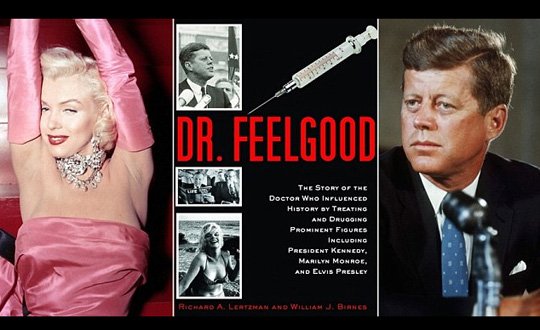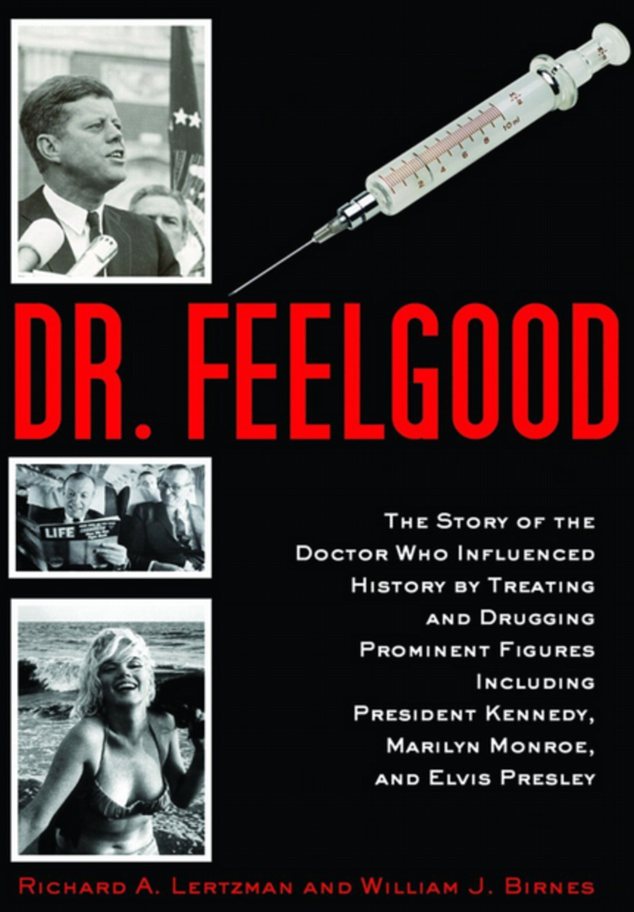

Dr. Max Jacobson’s medical treatments included meth addiction, hooking movies stars, writers, and even JFK.
In their book, Dr. Feelgood, authors Richard “Rick” Lertzman and Dr. William Birnes shoot a serious lethal injection into our present-day unease with Big Pharma. They tell a true cautionary tale so gruesome that it almost seems like a movie.
Actually it sort of was like a movie, filled with movie stars, writers, politicians, artists, and even the leader of the Western World, all of them hooked on what Dr. Feelgood had in his little black bag.
He was an ambitious star-fucker, this Dr. Max Jacobson. The hoi polloi, all insecure at heart, wanted to feel good so bad. The doc knew just the recipe: a little of this and a little of that, and a lot of methamphetamine.
The result of the injection was a powerful, orgasmic rush, so intense that the brain would be majorly bummed out if it weren’t getting it regularly, as Max knew from his own personal use.
Luckily for Dr. Feelgood, his treatments were highly sought-after and highly addictive, as was his obsession with power and fame. He simply mixed it up in his kitchen and stored the serum in vials, next to the pickles and the sandwiches.
What came next was a true-life Breaking Bad, where we follow the money, as well as Nazis, the CIA, The New York Times and a whole Who’s Who of glamorous addicts who were shooting themselves up silly.
Here, the authors give us the prescription for Dr. Feelgood.
Why had this story always been merely a historical footnote until the publication of your book?
Bill: One of the reasons was that for this story to have gotten into popular culture, the story of President Kennedy’s addiction to meth would have also been widely circulated.
What we found, at first, was rumor. The more we got into the research, we realized that there was a much bigger story. It was the story of a whole President’s career that was corrupted by his addiction to this drug. That was why this didn’t circulate widely.
What exactly is methamphetamine?
Rick: You felt like Superman. Max Jacobson was actually a very serious scientist and medical doctor working in Berlin. He was a brilliant researcher. He was a creator of a synthetic methamphetamine.
Nazi Germany wanted to use this formula for their Luftwaffe. They got ahold of his formula, while he escaped [to America]. His version was far more potent. It was liquid, and he added into it things like steroids and stem cells. You got an immediate jolt out of it.
Bill: If he was practicing today, he would be considered a hematologist, because he believed that blood work is key to the kinds of ailments that are affecting [sick people]. The serums he was testing on himself made him so sick that he added the meth to mask the impact of the blood serum he was using.
[Methamphetamine causes] the brain to become flooded with dopamine, and that’s what gives you that feeling of intense pleasure, incredible euphoria, as well as the psychotic symptoms of hyper-grandiosity.
It’s a false feeling but it’s a psychotic reaction. The more meth you get, the more dopamine is generated, and the more the psychotic reactions take over.
The ultimate psychotic reaction is manic depression. When the flow of dopamine stops, you become phenomenally depressed. That’s why it is chemically addictive. That’s what happened to all the people who became addicted to Jacobson’s shots.
How did he ingratiate himself into such powerful inner-circles?
Rick: He was highly ambitious, so when he came to America and set up an office, he fell in with [the great entertainment publicist] Milton Blackstone.
Blackstone started sending his clients to Jacobson, and Jacobson was, in essence, a star fucker. He loved the idea that he was treating all these well-known people. This was back in the early Fifties, and he started treating all the great powers in the country. Actors, actresses, writers, politicians.
Bill: Remember that Max Jacobson was addicted to methamphetamine himself. He was as addicted as any one of his patients. So that drug-induced hyper-grandiosity inspired him.
Rick: He was a real hustler.
And yet Jacobson never became wealthy himself?
Rick: He tried to. He had a meth lab, and he sold these drugs all over the country. It’s amazing that he never got rich. The lab continued for years and years until, finally, Jacobson was put out of business. In the end, he really did not have too much money.
 Bill: Jacobson, in real life, was very close to the Bryan Cranston character in Breaking Bad, because he has his own meth lab, and it was financed by some very heavy-hitters.
Bill: Jacobson, in real life, was very close to the Bryan Cranston character in Breaking Bad, because he has his own meth lab, and it was financed by some very heavy-hitters.
One of Jacobson’s most infamous patients was actor Bob Cummings, who was incredibly popular on television and in movies in the Fifties and Sixties.
Bill: We started out writing a book about Bob Cummings. Bob Cummings was known as a health fanatic. He wrote a book called How To Stay Young and Vital (1962). It was a huge best-seller. Everybody thought he was this “health food” guy and into very pure living. He had five kids.
[Many of his cast mates from different projects] confirmed that Cummings had a drug addiction. Julie Newmar [who co-starred with Cummings on TV’s My Living Doll] told us that he used to shoot himself in the ankle every morning. That’s when we started doing the work on the Max Jacobson book, because it shocked us.
[Due to Cummings’ addiction] he was blacklisted from television. He was eventually doing dinner theater. He moved out from this giant house and into this run-down apartment. When he died, he ended up with $35,000.
Of course, the John F. Kennedy connection was rumored for years.
Rick: Kennedy was dependent on [the injections]. He was shooting up 40 milligrams of methamphetamines at least three times a week.
[One episode] sent Kennedy on this psychotic episode where he stripped all of his clothing down at the [New York] Carlyle Hotel, and he played “Catch Me If You Can” with the secret service agents. He’s running up and down the hallways, going down stairwells, going up stairwells. And they don’t know what to do, because you can’t put the President in a straightjacket.
Jacobson’s undoing didn’t come until the 1970s, in the age of Watergate and newspaper exposes.
Rick: Originally, when The New York Times visited him, Jacobson thought this was his “coming out” party. He thought, now he’s going to get the exposure. [Up until now], he was flying under the radar. He thought this is where he is going to get his glory.
Bill: He was under restrictions, not revealing anything about JFK being treated with his drugs. That was part of the deal. From the moment Kennedy visited Jacobson’s office during the fall campaign in 1960, [Jacobson] was told: you must be completely silent about treating this person you are about to meet. And Jacobson kept that promise.
Rick: [The New York Times] sees this as an opportunity. This is their Watergate.
Bill: When Watergate began to break, The New York Times backed off the story. The Washington Post carried the story. So the Times took second place to the Post. So they felt (this Jacobson story) would get them back in the mainstream. Jacobson unwittingly became the poster boy for the Times’ resurgence.
Rick: So now it was exposed that all of these drugs were out there and there were no controls. At that time, Nixon started the Drug Control Act. Jacobson was the poster boy.
Bill: Methamphetamines were not illegal in 1972, but even back in the Forties and Fifties, Jacobson was under investigation by the FBI [for being a Communist agent].
So Max was finally shut down, but what was his legacy?
Rick: There are several layers of Max Jacobson and there are a lot of gray areas. Drug enforcement became a lot stronger. And what Jacobson did in the Sixties and Seventies still reverberates today.
What Max created is still strong. You look at Michael Jackson, or Anna Nicole Smith. It’s gotten bigger and bigger and bigger, and Max is the godfather of this whole methamphetamine movement.
Bill: That’s right. Max Jacobson went into popular culture after he died, as Dr. Feelgood. Nobody knew who Jacobson was personally, but they just knew the name Dr. Feelgood.
Read the incredible story here.
Find out more about the authors here.








